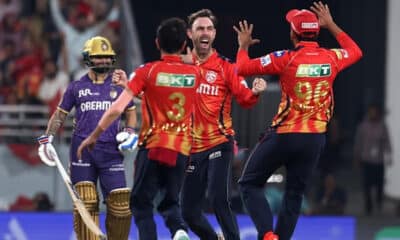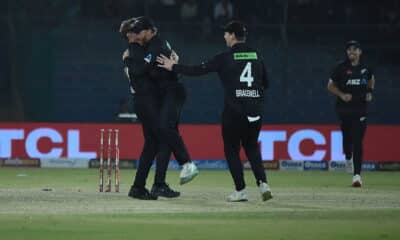
31 December 2019, by: Quintin van Jaarsveld
Proteas Team of the Decade
Some of the greatest players in South African cricket history graced the game over the past decade, writes Quintin van Jaarsveld.
Let’s start by acknowledging the elephant in the room. The curse continued and the choker’s tag stuck over the last 10 years. The trophy cabinet at Cricket South Africa’s (CSA) headquarters remains bare, although some of the all-time greats came through the doors during that time.
With the Proteas and the state of South African cricket as a whole at an all-time low, thanks in large part to rotten apples on the CSA board, things can only get better. By now, after years of underachievement and World Cup heartache, Proteas fans know the only way to support the side is with optimism.
While the future of the once-mighty Proteas is at the forefront of concerned fans’ minds, the past should not be forgotten and the greatest of the era deserves to be celebrated. With that in mind, here’s our selection for the Proteas XI of the decade across all three formats:
A legendary leader and fighter, Smith’s tenacity and competitive fire saw him blaze a trail as a terrific opening batsman and the most-successful Test captain in history. A blue-chipper, he became the youngest-ever Proteas captain at 22 and laid the foundation for the golden era (2002-2014).
Big, brash and bold, Smith instilled a new level of mental toughness in the South African team (for the most part). Not the flashiest, the left-hander was direct, powerful and patient; he didn’t mind working for his runs and dispatched anything on the leg side. Stylistically, “Biff” was unapologetic, unwavering and ultra-successful, bowing out with five double centuries to his name among a slew of accolades.
Class personified. Cool, calm and collected, Amla was a silent assassin who made his beautiful batting do the talking. “The Mighty Hash” as he became known, had the softest of hands and most educated of wrists, which saw him smoothly and subtly thread the needle. Amla was an artist. The Proteas’ Picasso, he painted masterpieces the world over and fittingly left his Mona Lisa for the Oval, where he scored an unbeaten 311 against England in 2012 – the highest Test score and only triple hundred by a South African batsman.
Widely regarded as the greatest player South Africa has ever produced, Kallis was a cricket cyborg who could do it all with perfect technique and had no weaknesses to speak of. The great ones make it look easy and that perfectly sums up Kallis’ unrivalled career. With the bat, he was both elegant and electric, graceful and destructive, while as a bowler, he was accurate, a constant threat who could swing the ball and often outwitted batsmen.
He also became the Proteas’ go-to golden arm and broke partnerships more often than not. He left behind a mountain of records that will be hard to break; most significantly, he’s the Proteas’ leading run-scorer in Tests (13 206) and ODIs (11 550) and the only player in the history of the game to score more than 10 000 runs and take over 250 wickets in both ODI and Test match cricket.
A nightmare to bowl to, “Mr 360” redefined batting during his illustrious career. A once-in-a-lifetime talent, a genius, a game-changer, a global superstar and an all-time great – De Villiers was all of these and more. Bursting onto the scene in 2014, he changed the very perception of what was thought possible on the pitch with a never-before-seen skillset and mercurial ingenuity. A true virtuously, he made a habit of producing jaw-dropping highlights and performances and racked up a string of records.
When he shockingly retired from international cricket in 2018, he held the world record for the fastest ODI 50 (16 balls), 100 (31 balls) and 150 (64 balls) and was the second-highest ODI run-scorer behind Kallis with 9 577 at an average of 53.50. On the Test arena, he boasted the second-highest individual score for South Africa (278*) and finished as the fourth-highest run-scorer with 8 765 (22 centuries) at an average of 50.66. Stats, however, don’t do justice the sheer genius of the man. The perfect example of his prodigious talent was his record-breaking 149 off 44 against the West Indies at the Wanderers in 2015 – one of the best innings you’ll ever see.
Du Plessis has provided the consistency the Proteas needed in the post-Kallis era. Of the current crop of Proteas, he boasts the most runs (3750) and the highest average (41.66) – now that’s leading from the front. Captaincy has brought out the best in Du Plessis; it’s highlighted his strengths and stoked his fire, which has given the Proteas killer instinct (for the most part). On the flip side, whenever the Proteas find themselves on the ropes, he’s the one who spearheads the fight-back. Technically sound with a dash of flair, Du Plessis can adapt his style to any match situation and boasts centuries in all three formats of the game. He’s a fantastic fielder as well.
Debuting in 2012, De Kock is South Africa’s version of Australian great, Adam Gilchrest – a fearless and ferocious wicketkeeper-batsman. Equally effective as an opener and lower down the order, he’s a bona fide match-winner. De Kock’s not always appreciated for the special talent he is. The prodigy’s perhaps the victim of a meteoric rise, which saw him equal the then-world record for the most successive ODI centuries (three) at 21 years of age. Since then, he’s been one of the current generation’s leading run-scorers, including scoring 17 50s and two hundreds. Still only 27, he’s maturing into a more consistent performer and by all indications, his best is yet to come.
In Philander, the Proteas found a consistent, deadly-accurate bowler they’d desired after Shaun Pollock called time on his glorious career in 2008. It took three years, but it was well worth the wait as Philander took the cricket world by storm, racking up 50 wickets in only seven matches, the second-fastest in Test history. He’s machine-like, not only with his ability to put the ball on a dime time and time again but with his tireless gas tank. The workhorse of his era, no-one put in longer spells over a longer period than “Big Vern”.
The biggest Proteas breakout star of the second half of the decade, Rabada has ripped through batting line-ups like few others. There’s no substitute for speed and “KG” is a special breed of speed merchant. Armed with a canon that sees him operate in the 140-150km/h range and fuelled by a channelled aggressive attitude, Rabada is the stuff of nightmares.
He holds the distinction of being the youngest Proteas bowler to take seven wickets in an innings, claiming 7/112 in the Test against England in Centurion in 2016, became the youngest bowler in history to top the ICC Test rankings at 22 years and 231 days in 2018 and took a record-breaking 11 wickets against Australia at St George’s Park that same year.
When it comes to South African bowlers, Steyn’s the undisputed GOAT. Not only is he the Proteas’ leading wicket-taker in Test cricket, claiming an astonishing 439 victims, but he’s also the most intense and feared fast bowler to ever come out of South Africa. A snarling, fire-breathing quick, he has an aura about him, an intimidating presence garnered over 16 years as the Proteas’ destroyer-in-chief.
Mostly celebrated for his blistering speed, equally key to “The Phalaborwa Express'” unrivalled success has been his ball control; he’s laser-accurate, can swing it both ways, has one of the most deceptive slower balls in the business and a wicked bouncer.
It’s one thing to be a skyscraper but another to make the most of that natural gift. Morkel maximised every inch of his 1.96m frame to fire heat-seeking missiles at harrowing and often punishing heights. The yin to Steyn’s yang, Morkel wasn’t as aggressive and expressive as his long-time teammate, which made him the perfect partner. Silent and deadly, Morkel was a mainstay in the ICC top 10 list for most of his career and was the number one ODI bowler in the world in 2011. Three years later, he delivered a devastating, career-best spell of 5/21 to propel the Proteas to victory over Australia in Perth.
Cricket’s Chris Angel, Tahir’s consistently left batsmen and fans in disbelief with his magical spin bowling, producing deliveries that seemingly defied the laws of physics. Born in Punjab, he was like a godsend – the ultimate spin wizard the Proteas had longed for to round off their bowling attack when he debuted in 2011.
Since then, he’s cemented his legacy as an all-time leg break legend and the best spinner in South African history. A colourful character with an iconic celebration, he’s only the second Protea in history to take nine wickets in an innings, rattling off 9/129 against Sri Lanka in Colombo in 2018 and boasts the best ODI figures in South African history – 7/45 against the West Indies in Basseterre in 2016.
MORE STORIES





















